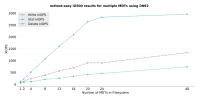Details
-
Improvement
-
Resolution: Not a Bug
-
Major
-
None
-
Lustre 2.13.0
-
9223372036854775807
Description
While testing in an environment with a single parent directory following by 1 shared sub directory for all client mdtest ranks, we are observe very little scaling when moving to more than 2 MDTs. See below for 1 million objects per MDT, 0K File Creates:
1 MDTs - 83,948
2 MDTs - 115,929
3 MDTs - 123,186
4 MDTs - 130,846
Stats and deletes are showcasing similar results. It seems to not follow a linear scale but instead plateaus. It would also seem that we are not the only ones to observe this. A recent Cambridge University IO-500 presentation presented a slide with very similar results (fourth from the bottom): https://www.eofs.eu/_media/events/lad19/03_matt_raso-barnett-io500-cambridge.pdf
Attachments
Issue Links
- is related to
-
LU-9436 DNE2 - performance improvement with wide stripping directory
-
- Open
-

I also shared shared-directory_mdt-perf.tar.gz, which consists of the flamegraphs of the original test that correlate to the numbers posted above in the description. Note that in the tarball, mdt0-1total consists of the single MDT testing while the rest of the subdirectories inside the archive are each MDT in a 4 MDT configuration.